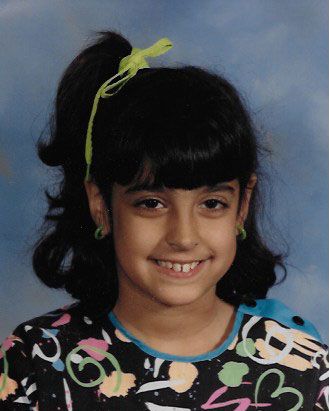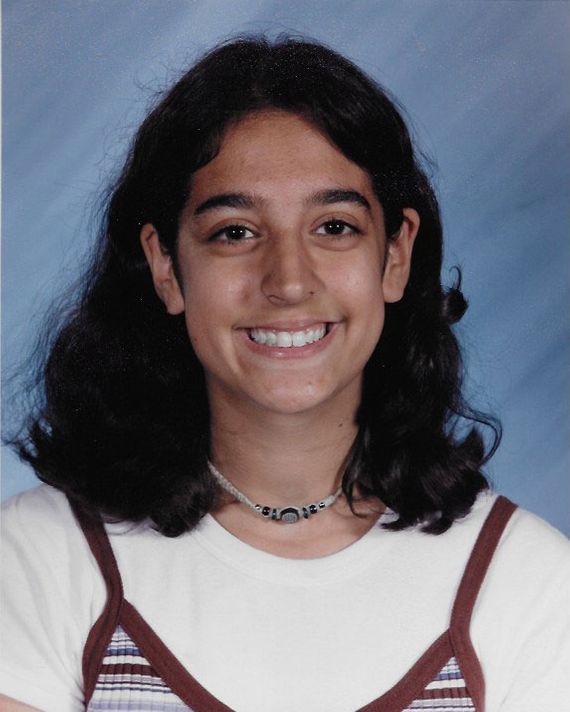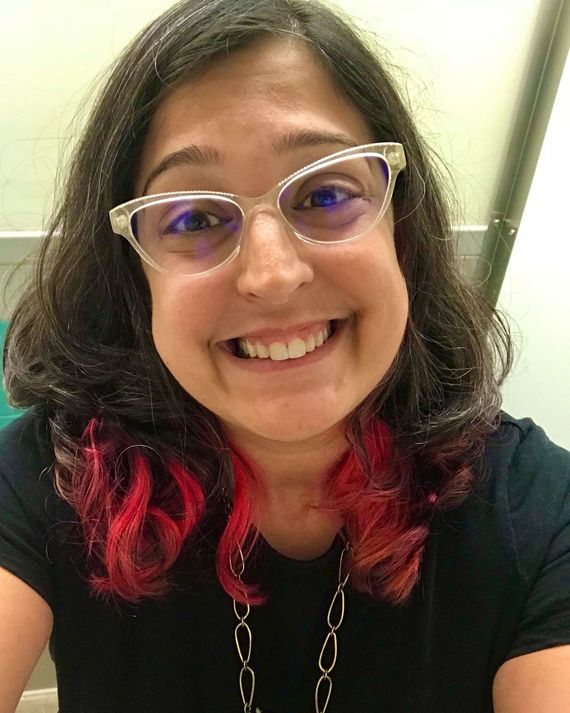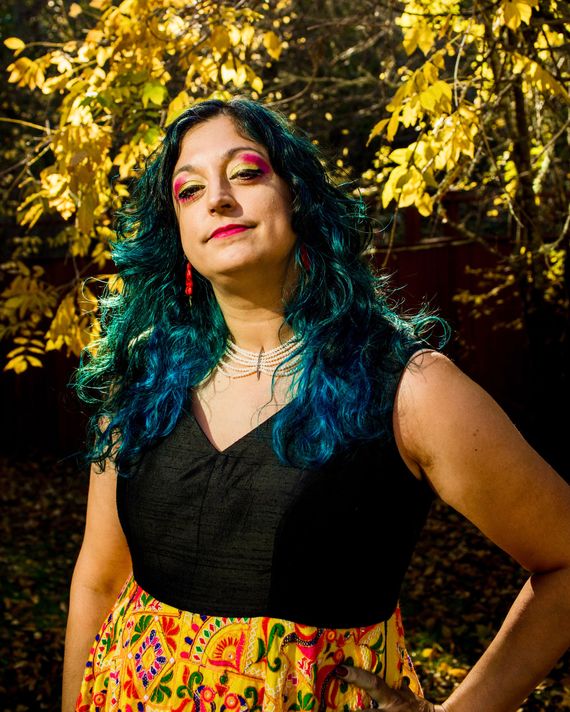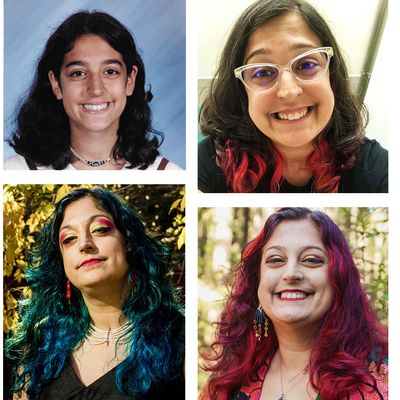
I was 16 when I found my first gray hair. Judging by its multiple siblings, it had likely been there for a while. I was playing the xylophone in my high-school band when a friend standing behind me pointed it out. The strangest part was that the hair wasn’t gray, but a pure white from root to tip. It felt wrong, foreign, like an invader on my body. This is only supposed to happen to old people, I thought as I yanked it out.
Racism first affected me at 9. The animated show The Simpsons had come out that year, and most parents allowed their kids to watch it, not aware of the content. Apu was an Indian character who worked at a convenience store similar to 7-Eleven, selling icy drinks and day-old hot dogs. Voiced by a white man with an exaggerated accent, Apu was always the butt of jokes, including for his melodic catchphrase, “Thank you, come again!” Being Indian, anytime I saw a scene with Apu, a small ball of shame the size of a peach pit slowly pulsed in my chest.
The first time someone asked me if my dad worked at 7-Eleven, it caught me off guard. Not understanding, I explained that my dad was actually a forensic scientist. “Are you sure?” the boy asked. “I bet he says, ‘Would you like to buy a Slurpee?’” Everyone around me laughed, as I just stood there, confused and embarrassed.
By junior high, the racist taunts were happening multiple times a day. I gave a speech on India, bringing in crispy fried papad to hand out, and was pelted with spitballs as kids spoke over me, saying, “Thank you, come again” and mocking my “stinky” food. The cool girls in class used their Lip Smackers lip gloss to put fake bindis on their head, while the teacher smiled, ignoring it all. A fight with a girlfriend led to her friends following me around at lunch, repeating Apu’s phrases and spitting chewed-up food into my hair. I brushed the food out of my thick and wavy dark-brown hair, the results of my dad’s black Indian hair and my white mother’s lank light-brunette hair. I’d fake being sick so I could leave school or not go at all, hanging out at home watching old TV shows, where it felt safe. After school, the prank phone calls started, crushing my safe space. I started having anxiety attacks anytime the phone rang.
I had hoped high school would be different. Instead, strangers and acquaintances alike would hurl racial epithets at me on the regular. I’d divulge to a few close friends. “Oh, Leena, stop being so paranoid! No one is talking about you!” they’d always respond. I would have given anything to have just one teacher in school defend me or explain what was happening. My adolescent brain only understood that I was the butt of everyone’s jokes and unpopular because of my looks, so something must be wrong with me. I didn’t tell my dad or my mom because the embarrassment was overwhelming. The shame ball in my chest was now the size of a grapefruit, pulsing every hour of every day. I spent a lot of time alone. What I didn’t know was that my dad was dealing with racist taunts similar to mine: “What camel did you ride to work today?”; promotions were denied because of race.
I had no idea that racist interactions like that would drain the color out of my hair in patches, a visual diary of its impact that I wore daily. And never could I have imagined how my adult self would start the healing process by choosing brightness.
Throughout my 20s, I continued to pull my white hairs out, confused as to why they kept coming back. I experimented with dyeing my hair a little, bleaching and adding bright-red or Superman-blue highlights. But dying my own gray hair back to dark brown never felt right. Even in my own family, I felt like an outsider. My mom had dyed her naturally light-brown-and-gray hair a dirty blonde for as long as I can remember. My Indian aunts all dyed their hair an inky, unnatural shade of black to hide their grays. In India, my cousin kept trying to get me to go to a salon with her. “Why?” I asked her. She pointed at my gray hairs as she explained in her halted English. “Gray is no good.” For the next decade of my life, I let my hair color transition from dark brown to salt-and-pepper.
At 37, a few months after the birth of my third child, I dyed my hair pink. “What do you think?” my hairstylist asked. Serotonin bubbled over in my brain like a soda slammed on the table as I tried to find the words for how this made me feel. “It just feels right,” I said.
Bright colors felt like a homecoming. Each subsequent trip to the salon resulted in more color, graduating to fully bleaching and dyeing the bottom half of my hair with highlights and gray coverage at the top, shades of candy-apple red and the most vivid violet.
Two years later, I came across a study published in January 2020 by a Harvard stem-cell scientist who investigated Marie Antoinette syndrome, or premature graying, named after the French queen whose hair went completely white the night before she was killed at the guillotine. By putting mice through a series of acute stressors, the study confirmed that premature graying was caused by the sympathetic nervous system, which is the body’s natural alarm, controlling its quick involuntary response to stress or danger. This is what causes fight-or-flight to happen. The study found that even quick episodes of fight-or-flight can permanently alter stem cells. In other words, stress happens, and the sympathetic nervous system overreacts, exhausting the stem cells responsible for hair color, which can lead to premature graying. Sure, mice aren’t human, but photos of presidents before and after their time in office prove that it affects us too.
During the early pandemic in 2020, trauma triggers were already overrunning my life, causing me to jump into fights for justice in person and online with zero mental space available. Around that time, I found a huge new patch of gray on the left side of my head. I grabbed the bleach and the brightest teal hair color that I could find and had a friend apply it. My hair was a gorgeous mix of teal, blue, and green based on how the hair dye affected my different types of hair, almost a mermaid effect that uplifted me every time I looked in the mirror.
In September 2020, at age 40, my 9-year-old daughter and I were doing Black Lives Matter chalk drawings on neighborhood stairs when an older white neighbor screamed, “All lives matter!” She argued with me, took our photo to show the police, threw a bag of dog shit that hit my kid in the head, and hit and kicked me when I returned her dog shit to her. This attack caused decades of unprocessed trauma to bubble to the surface in the form of severe anxiety and depression that left me barely functioning. More gray hair appeared, and I tackled it with more teal hair dye.
It took going to a mental-health treatment center to get diagnosed with complex post-traumatic stress disorder, mostly due to racism. It’s why I fought with the attacker on the stairs. No adult had ever stood up for me against racism, and my daughter deserved better.
“Having PTSD is like having your body’s danger alarm constantly going off, forcing you to become hypervigilant, almost stuck in fight-or-flight,” my trauma therapist explained to me. I thought back to 16 and the gray hair started to make sense.
I realize now that the colorful ways I covered up my gray hair was a part of my healing process. The shame ball still lives in my chest, but thanks to tons of therapy, regulation skills, and, of course, bright hair dye, I can keep it from growing too big.
Some people wear gray hair like a badge of honor, and some are proud that they have made it to a certain age or part of their life, while some young adults today dye it silver as a fashion statement. There are still women like my aunts who dye their hair to match their natural hair color. When I dye my hair a bold, bright color, I’m not trying to hide from my age or past traumas. I’m speaking my truth, turning my hair into a vibrant banner: This is what life did to me and my hair, and just look at all of the beauty that I’m breathing into it.


